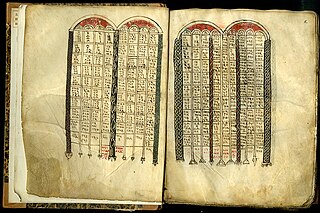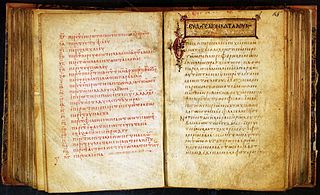
The Codex Sinaiticus, designated by siglum א [Aleph] or 01, δ 2, also called Sinai Bible, is a fourth-century Christian manuscript of a Greek Bible, containing the majority of the Greek Old Testament, including the deuterocanonical books, and the Greek New Testament, with both the Epistle of Barnabas and the Shepherd of Hermas included. It is written in uncial letters on parchment. It is one of the four great uncial codices. Along with Codex Alexandrinus and Codex Vaticanus, it is one of the earliest and most complete manuscripts of the Bible, and contains the oldest complete copy of the New Testament. It is a historical treasure, and using the study of comparative writing styles (palaeography), it has been dated to the mid-fourth century.

The Codex Vaticanus, designated by siglum B or 03, δ 1, is a Christian manuscript of a Greek Bible, containing the majority of the Greek Old Testament and the majority of the Greek New Testament. It is one of the four great uncial codices. Along with Codex Alexandrinus and Codex Sinaiticus, it is one of the earliest and most complete manuscripts of the Bible. Using the study of comparative writing styles (palaeography), it has been dated to the 4th century.

The Codex Ephraemi Rescriptus designated by the siglum C or 04, δ 3, is a manuscript of the Greek Bible, written on parchment. It contains most of the New Testament and some Old Testament books, with sizeable portions missing. It is one of the four great uncials. The manuscript is not intact: its current condition contains material from every New Testament book except 2 Thessalonians and 2 John; however, only six books of the Greek Old Testament are represented. It is not known whether 2 Thessalonians and 2 John were excluded on purpose, or whether no fragment of either epistle happened to survive.

Codex Koridethi, also named Codex Coridethianus, designated by siglum Θ or 038, ε050, is a Greek uncial manuscript of the New Testament, written on parchment. Using the study of comparative writing styles (palaeography), it has been assigned to the 9th century CE. The manuscript has several gaps.

Codex Washingtonianus, Codex Washingtonensis or Codex Freerianus, designated by W or 032, ε014, also called the Washington Manuscript of the Gospels, The Freer Gospel and The Freer Codex, is a Greek uncial manuscript of the four Gospels, written on parchment. Using the study of comparative writing styles (palaeography), it has been dated to the 4th or 5th century. The manuscript has some gaps.

Codex Basilensis, designated by Ee, 07 or ε 55, is a Greek uncial manuscript of the four Gospels, dated paleographically to the 8th century.

Uncial 030, designated by siglum U or 030, ε 90, is a Greek uncial manuscript of the New Testament on parchment, dated palaeographically to the 9th century. The manuscript has complex contents, with full marginalia.

Codex Cyprius, designated by Ke or 017, ε71, or Codex Colbertinus 5149, is a Greek uncial manuscript of the four Gospels, written on parchment. It is one of the few uncial manuscripts with the complete text of the four Gospels, and it is one of the more important late uncial manuscripts. It was brought from Cyprus to Paris.

Codex Mosquensis I designated by Kap or 018, Απρ1 (Soden), is a Greek uncial manuscript of New Testament, palaeographically it has been assigned to the 9th century. The manuscript is lacunose.

Codex Regius, designated by siglum Le or 019, ε56, is a Greek uncial manuscript of the New Testament written on parchment. Using the study of comparative writing styles (palaeography), it has been assigned to the 8th century. The manuscript has several gaps. Textual critic Frederick H. A. Scrivener described it as "by far the most remarkable document of its age and class."

Codex Tischendorfianus IV – designated by Γ or 036, ε 70 – is a Greek uncial manuscript of the Gospels, dated palaeographically to the 10th century. The manuscript is lacunose.

Codex Sangallensis, designated by Δ or 037, ε76, is a Greek-Latin diglot uncial manuscript of the four Gospels. Using the study of comparative writing styles (palaeography), it is usually dated to the 9th century CE, though a few palaeographers would place it in the 10th century CE. It was given its current name by biblical scholar Johann Martin Augustin Scholz in 1830.

Codex Tischendorfianus III – designated by siglum Λ or 039, ε 77 – is a Greek uncial manuscript of the Gospels on parchment. Palaeographically it has been assigned to the 9th or 10th century.

Codex Zacynthius (designated by siglum Ξ or 040 in the Gregory-Aland numbering; A1 in von Soden) is a Greek New Testament codex, dated paleographically to the 6th century. First thought to have been written in the 8th century, it is a palimpsest—the original (lower) text was washed off its vellum pages and overwritten in the 12th or 13th century. The upper text of the palimpsest contains weekday Gospel lessons (ℓ299); the lower text contains portions of the Gospel of Luke, deciphered by biblical scholar and palaeographer Tregelles in 1861. The lower text is of most interest to scholars.

Codex Petropolitanus, designated by Π or 041, ε 73, is a Greek uncial manuscript of the Gospels, dated palaeographically to the 9th-century. The manuscript is lacunose.
The Codex Athous Laurae, designated by Ψ or 044, or δ 6, is a manuscript of the New Testament written in Greek uncial letters on parchment. The manuscript has many gaps in the text, as well as containing handwritten notes. Using the study of comparative writing styles (palaeographically), the codex is dated to the 8th or 9th century.

Minuscule 33, δ 48 (Soden), before the French Revolution was called Codex Colbertinus 2844. It is a Greek minuscule manuscript of the New Testament on parchment, dated palaeographically to the 9th century. The manuscript is lacunose. It has marginalia. According to the textual critics it is one of the best minuscule manuscripts of the New Testament.
Minuscule 28, ε 168, formerly known as Colbertinus 4705, is a Greek minuscule manuscript of the New Testament, written on vellum. Using the study of comparative writing styles (palaeography), it has been dated to the 11th-century. It contains marginal notes (marginalia), and has several gaps.
Lectionary 260, designated by siglum ℓ260 is a Greek manuscript of the New Testament, on parchment. Palaeographically it has been not assigned to any century. Scrivener labelled it as 198e, Gregory by 83a. The manuscript has been lost.
Textual variants in the Gospel of Mark are the subject of the study called textual criticism of the New Testament. Textual variants in manuscripts arise when a copyist makes deliberate or inadvertent alterations to a text that is being reproduced. An abbreviated list of textual variants in this particular book is given in this article below.
















